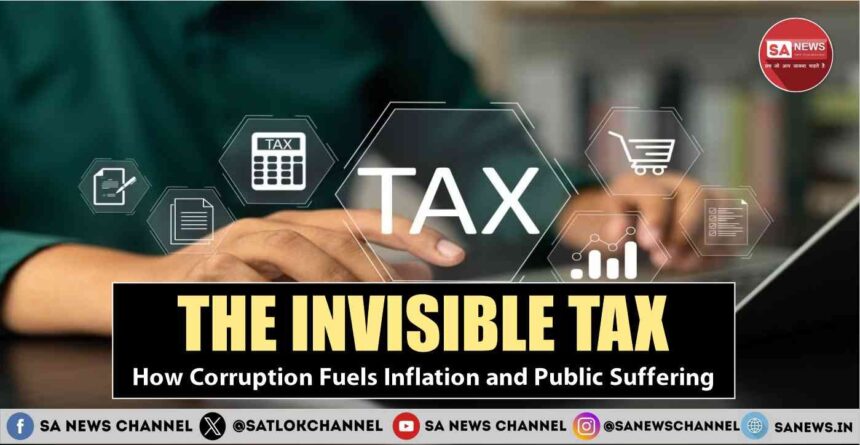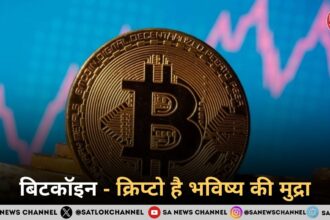Corruption is not just about bribes or under-the-table deals. It is a deep, systemic cancer that quietly drains national resources, inflates public costs, erodes institutions, and punishes honest citizens. In countries like India, where corruption has infiltrated every level of government and private interaction, its impact goes far beyond morality or ethics. It affects economic growth, increases inflation, deepens inequality, and fuels national debt. In short, corruption cripples a nation’s economy from the inside out.
- Highlights on Invisible Tax
- Corruption and Inflation: A Hidden Link
- Corruption and National Debt: A Designed Disaster
- Stunted Economic Growth
- Weak Institutions and Governance
- Erosion of Public Trust
- Inequality and Social Impact
- How Deep the Rot Goes: India’s Corruption Crisis in Numbers
- A Rising Tide of Corruption Cases:
- A Justice System That Can’t Keep Up:
- Categories of Corruption: Where It Happens Most
- India’s Most Corrupt States (by Cases Filed):
- The Cost of Corruption: Financial and Social Impact
- Why So Many Cases “Disappear”:
- What Can Ordinary People Do? A Fight Bigger Than Headlines
- Conclusion: The Rot Beneath the Surface
- True Knowledge: The Only Way Out
- FAQs on Invisible Tax
Highlights on Invisible Tax
This article explores how corruption acts as an invisible tax that weakens economies from the inside. It reveals how large-scale corruption in countries like India; directly drives inflation, expands national debt, and suffocates growth. From inflated public spending to eroded public trust, the article unpacks the many ways corruption distorts markets, discourages investment, weakens institutions, and deepens inequality. With a special focus on how systemic corruption fuels fiscal instability, it urges for transparency, accountability, and reform to protect both individual livelihoods and national prosperity.
Corruption and Inflation: A Hidden Link
At first glance, corruption may seem like a moral issue rather than an economic one. But in truth, it is a major underlying driver of inflation, subtly raising the cost of living for everyone while weakening a country’s fiscal health.
Wasteful Spending:
The first major pathway is wasteful government spending. Corrupt officials often approve overpriced or unnecessary projects, inflating budgets to pocket their share through kickbacks. To fund these inflated costs, the government either prints more money or borrows excessively, both of which push inflation higher. More money in the system chasing the same goods inevitably leads to price hikes.
Supply Chain Disruptions:
Next, corruption causes supply chain disruptions. Bribes in the procurement or licensing process distort market efficiency. Contractors who pay off officials may deliver substandard goods or services, and honest suppliers are pushed out of the system. These inefficiencies delay production and lower the quality and quantity of goods, which reduces supply and drives prices upward.
Cash Circulation & Black Money:
A more subtle contributor is the influx of black money. Corrupt dealings often go unreported and untaxed, injecting large sums of illicit money into the economy. This increases cash circulation and demand, but since the supply of goods doesn’t rise proportionally, prices climb; further intensifying inflation.
Subsidy Leakages:
Finally, corruption leads to subsidy leakages. Government welfare programs designed to help the poor often fall victim to embezzlement and fraud. When funds are siphoned off by corrupt intermediaries, the government ends up spending more to compensate for the leakage. This disrupts fiscal planning and adds pressure on national budgets, contributing once again to inflation.
Corruption and National Debt: A Designed Disaster
Corruption doesn’t just eat into a nation’s resources; it plays a direct role in pushing countries deeper into debt. When governments consistently lose revenue due to corruption, they are left with little choice but to borrow money to fill the financial gaps, triggering a cycle of unsustainable debt.
Revenue Loss:
The first major issue is revenue loss. When bribery becomes widespread, businesses and individuals often underreport income or evade taxes with the help of corrupt officials. As a result, tax collection declines sharply. With reduced income, the government has fewer funds for essential services and is forced to rely more heavily on loans to keep operations running.
Inflated Public Project Costs:
This borrowing is made worse by inflated public project costs. Corrupt officials and contractors often overprice infrastructure or development projects to siphon off funds. These artificially bloated costs lead to larger loans being taken just to complete the same amount of work, leaving taxpayers with more debt and less value in return.
Debt Trap:
Then comes the problem of debt recycling. When previous loans come due, the government often doesn’t have the resources to repay them partly because corruption has undermined efficiency and productivity. Instead, new loans are issued to pay off old ones, creating a compounding debt trap that grows larger with each cycle.
To Understand How This Phenomenon occurs more clearly and with greater insight read how the world is: $102 Trillion in Debt: How Money Became an Illusion We All Believe In.
Decline in Foreign Investments:
Finally, foreign investors become hesitant in the face of systemic corruption. Corruption erodes legal protections, skews markets, and increases business risk, all of which deter Foreign Direct Investment (FDI). Without steady external capital, the country loses a vital source of non-debt revenue and becomes even more reliant on borrowing.
Also Read: How to Scale Your Startup Successfully: The Ultimate Growth Guide
In this way, corruption doesn’t just create financial inefficiencies, it builds a debt machine where misused funds, lost revenue, and reduced investor trust feed into one another. The system keeps borrowing not as a temporary fix, but because corruption has made it structurally dependent on debt just to survive.
Stunted Economic Growth
Poor Infrastructure:
Corruption diverts national resources from productive public use to private enrichment, deeply affecting economic progress. A clear example is poor infrastructure. When bribes are paid to approve low-quality materials or unqualified contractors, roads, bridges, and utilities end up substandard. This not only wastes money but also slows commerce, trade, and connectivity.
Stunted Entrepreneurship:
Entrepreneurship also suffers. Honest businesses are discouraged when they see competitors gaining unfair advantages by bribing officials for licenses, tax breaks, or regulatory exemptions. It creates an uneven playing field where merit loses and manipulation wins.
Loss of Talent:
This climate drives a brain drain, as skilled and educated individuals migrate to cleaner, more transparent economies where talent and hard work are rewarded fairly. The home country is left with a shortage of human capital which is its most valuable asset for sustainable growth.
Weak Institutions and Governance
When corruption infiltrates a system, institutions weaken and begin to crumble. Selective law enforcement becomes common, where the powerful evade accountability while ordinary citizens bear the brunt of a broken justice system, fueling public resentment. Judicial corruption adds to the crisis; delayed or biased rulings and lack of transparency erode trust and make both individuals and businesses feel legally unprotected.
This uncertainty discourages investment and undermines the rule of law. Furthermore, corrupt governments often introduce excessive and complex regulations, not to ensure order, but to create more opportunities for bribery. These laws become tools of extortion rather than mechanisms of justice.
Erosion of Public Trust
As corruption becomes entrenched, public trust erodes. Citizens lose faith in government institutions, reducing civic participation and weakening democracy. Voter apathy increases, allowing corrupt leaders to remain in power with little resistance.
Eventually, growing frustration leads to protests, unrest, and even violence, as people feel their voices are ignored and justice is inaccessible. Instead of being a source of security, the state is seen as part of the problem.
Inequality and Social Impact
Corruption disproportionately harms the poor and vulnerable. Public services like schools, hospitals, and welfare programs underperform when funds are siphoned off. Teachers may be unqualified, medicines unavailable, and basic needs unmet, not because of lack of policy, but because of theft.
Meanwhile, the poor end up paying more. Unlike the rich, they can’t bribe their way out of problems. Instead, they wait in long queues, endure broken systems, or pay inflated prices due to corruption-driven inefficiencies.
Worse, systemic injustice can lead to increased crime and violence. When people feel that legal paths are blocked and opportunities stolen, desperation grows, and some turn to illegal means for survival, creating a dangerous feedback loop that further destabilizes society.
How Deep the Rot Goes: India’s Corruption Crisis in Numbers
Behind every delayed road, every broken government hospital, every missing school bench, and every staggering hike in public project cost lies a much deeper rot :- corruption. And while many believe it’s an occasional nuisance or isolated to politics, the numbers paint a grimmer and more systemic picture.
A Rising Tide of Corruption Cases:
Over the past few years, India has seen a consistent rise in corruption cases officially registered under the Prevention of Corruption Act. As per data from the National Crime Records Bureau (NCRB), 3,123 cases were registered in 2020, followed by 3,745 in 2021, and 4,139 in 2022. That’s a 33% increase in just two years, a reflection of both deeper scrutiny and worsening malpractice.
These figures amount to an average of 3,670 cases per year between 2020 and 2022 and remember, this only includes reported and registered cases. Tens of thousands or even Lakhs more go undetected or unreported due to fear, lack of faith in legal outcomes, or the normalization of bribery in daily life.
Despite this increase in vigilance, the justice system is still deeply clogged. By the end of 2022, over 11,140 cases were still pending investigation, many of them stalled for years without progress. The sheer backlog weakens the credibility of anti-corruption institutions and disincentivizes whistleblowers.
A Justice System That Can’t Keep Up:
What happens after a corruption case is registered? Unfortunately, not much in most cases.
Take 2022 as an example: Out of 4,993 individuals arrested on corruption charges, only 852 were convicted. That’s a conviction rate of just 17% for those arrested. The national average conviction rate across all corruption cases is slightly higher at 39.6%, but even that means nearly 60% of cases end in acquittal or are dismissed due to insufficient evidence, legal loopholes, or lack of political will.
Even worse, 94% of Maharashtra’s corruption cases remain pending in courts, despite being the most active state in filing such FIRs. And when officials are convicted, the penalties are often laughable. For instance, Maharashtra’s Anti-Corruption Bureau reported that in 2023, only 20 convictions were secured, and the total fines collected were a mere ₹8.14 lakh. Most of these convictions involved low-level government employees, leaving the bigger fish untouched.
Categories of Corruption: Where It Happens Most
Corruption in India doesn’t just wear one face. The NCRB data from 2022 breaks it down:
- Trap Cases (≈70%) – These involve public servants caught red-handed accepting bribes. The high proportion may suggest a preference for easily provable cases.
- Criminal Misconduct (13%) – Cases where officials misuse power or commit breaches of trust.
- Disproportionate Assets (9%) – Involving officials accumulating wealth far beyond their known sources of income.
- Others (≈8%) – Including indirect bribes, procedural violations, and cases under miscellaneous sections.
While trap cases are important, the overwhelming focus on them indicates a reactive system, not a preventive or structural one. High-level corruption; the kind that drains national resources, often remains untouched or deliberately uninvestigated.
India’s Most Corrupt States (by Cases Filed):
Corruption knows no borders, but some states have become hotbeds, either due to deeper rot or stronger enforcement mechanisms. Based on NCRB data:
- Maharashtra: Leads the list with 749 cases in 2022, 773 in 2021, and 664 in 2020. However, conviction rates remain abysmal; as low as 8–9%.
- Rajasthan: Regularly ranks second. Although exact numbers aren’t detailed each year, the state consistently appears in the top two.
- Madhya Pradesh: Known for a high number of trap cases. While that shows activity, it also reflects deep systemic corruption.
- Haryana: Reported a major jump in cases from 79 in 2021 to 246 in 2022; over 3x increase in one year.
- Punjab: With 227 cases in 2022, Punjab also had the highest number of arrests (350) under anti-corruption actions that year.
Other states like Tamil Nadu, Odisha, and Karnataka also report high numbers, but the above five lead in filings and arrests.
The Cost of Corruption: Financial and Social Impact
One of the most dangerous features of corruption is its invisibility in macroeconomic metrics. While GDP might show growth, corruption silently bleeds public funds.
- A 2013 FICCI-EY report estimated that ₹36,400 crore was lost in just one year (2011–12) due to reported corruption, largely from leaked subsidies, inflated contracts, and manipulated tenders.
- Individual cases often involve multi-crore bribes, with investigators frequently seizing properties worth crores from single officers.
In Punjab, a former AIG of police was arrested for a ₹1 crore bribe and Enforcement Directorate attached ₹1.29 crore in unexplained assets. Yet, what gets recovered is negligible. Even after convictions, fines and asset seizures remain low. The state ends up spending more money on legal proceedings than it recovers from the guilty.
Why So Many Cases “Disappear”:
Corruption thrives in darkness, and legal delays act as its perfect cloak. Investigations drag on, key witnesses withdraw under pressure, evidence is “lost,” and files go missing.
In many cases:
- Officials are transferred or promoted before investigations conclude.
- Political influence or bureaucratic protection ensures stalling of trials.
- Anti-corruption units lack resources or political backing to pursue high-profile targets.
Moreover, departmental actions are minimal. In 2022, disciplinary actions were taken in just 445 cases, and only 2 officials in Maharashtra were removed from service, a state with hundreds of cases.
What Can Ordinary People Do? A Fight Bigger Than Headlines
Corruption, inflation, and debt might seem like issues only governments can fix, but real change begins at the ground level. Every citizen plays a part.
Start by refusing to pay bribes, no matter how small. Normalizing corruption gives it power. Use RTI and anti-corruption platforms to report wrongdoing. Vote consciously; not for charisma or caste, but for candidates with clean records and transparent agendas.
Demand transparency in your local governance; attend meetings, ask for audits, raise your voice. Support whistleblowers who risk everything to expose injustice. Teach the youth about the economic cost of dishonesty and the value of integrity.
Choose ethical businesses, ask for receipts, and stay informed. These small actions create big shifts.
Conclusion: The Rot Beneath the Surface
Corruption isn’t just a moral failure; it’s an economic disaster at the core of India’s governance. From bribes in offices to broken hospitals, these daily struggles reveal a deeper rot that fuels inflation, weakens the rupee, and drives national debt.
With over 60% of cases ending in acquittal or delay, corruption has become a low-risk, high-reward game eroding public trust and damaging the economy. But this fight isn’t just for leaders, every citizen plays a role. By refusing bribes, voting responsibly, and demanding accountability, change begins. No reform or budget can succeed unless corruption is tackled head-on. Because corruption is the one tax we never chose; and yet, we pay for it every day.
True Knowledge: The Only Way Out
As long as we live in this world, we are bound to be influenced by its vices. Every human, regardless of status, acts to fulfill inner desires: comfort, control, recognition, or wealth. This endless chase stems from a deeper cause.
According to the Bhagavad Gita, this world is ruled by Kaal, a negative power who sustains it through deception and suffering. Under his influence, we are trapped in greed, pride, and ego; unknowingly tied to the cycle of birth and death. Sant Rampal Ji Maharaj explains that this cycle continues because we lack Satgyaan; true spiritual knowledge.
Corruption is just one visible effect of our attachment to maya, or temporary material wealth. But money and power cannot protect us from sorrow. A disciple who hoarded black money once lost his son despite all his wealth. It was then that Sant Rampal Ji Maharaj explained: karmic consequences follow us across lifetimes, and only Satya Bhakti, true devotion to the Supreme God, can end that suffering.
The Vedas confirm that the True God, Kabir Saheb, can even erase destined fate if worshipped correctly. Satgyaan opens our eyes, uplifts our actions, and leads us beyond corruption. By transforming ourselves through truth, we begin to transform the world.
FAQs on Invisible Tax
- What is corruption?
Ans:- Corruption is the abuse of entrusted power for personal gain. It includes bribery, embezzlement, favoritism, fraud, and misuse of authority in both public and private sectors.
- What are the major causes of corruption?
Ans:- The main causes include greed, lack of accountability, weak enforcement of laws, low wages in public services, excessive red tape, and societal acceptance of unethical shortcuts.
- What are the Impacts of Corruption?
Ans:- Corruption leads to poor public services, loss of government revenue, inflation, increased poverty, reduced foreign investment, weakened rule of law, and growing inequality in society.
- What is the main form of corruption in India?
Ans:- The most common form is bribery, especially in government offices. Trap cases, where officials are caught red-handed; make up nearly 70% of corruption cases in India, according to NCRB data.
- How does corruption affect the economy?
Ans:- It inflates project costs, discourages honest businesses, creates black money, lowers tax collection, increases national debt, and undermines confidence in markets and institutions.
- What is the relation between inflation and corruption?
Ans:- Corruption increases money circulation through black income, drives inefficient public spending, and distorts supply chains; causing shortages and price hikes, which in turn fuel inflation.









